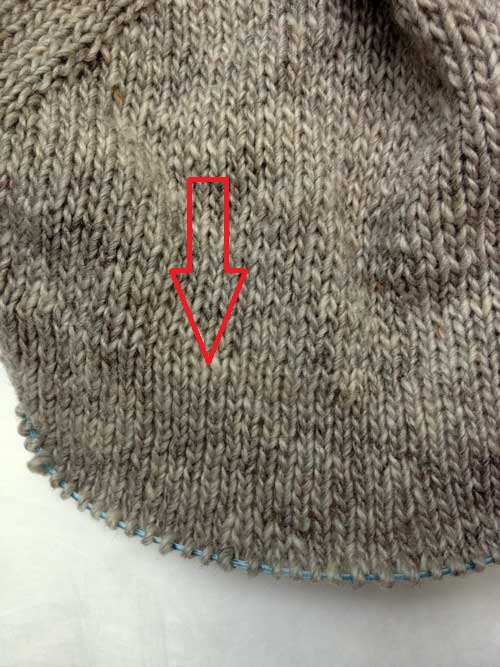Kate had an “ah-hah” moment in the midst of working on a sample of Heidi Kirrmaier’s Vitamin D cardigan that we thought might be worth sharing. She cast on for the top-down pattern using Spinnery Sylvan Spirit in the Sterling colorway.
She is thrilled with how the yarn is knitting up and things were sailing along smoothly until she started working her first sleeve. Unlike similarly constructed top-down sweater patterns, Heidi has the knitter put the body stitches on hold while working the sleeves first. The pattern includes a note in italics explaining her directions.
“Note: instructions are for working the sleeve flat in order to ensure the same tension as yoke is maintained.”
Kate decided that the simplicity of working the sleeves in the round was worth any small shifts in tension that she was confident she could block out…do you see where this is going?
She didn’t have to work very far on her sleeve to have about an inch or two worth of stitches to test her theory.*
The difference between the worked-flat stockinette and the worked-in-the-round stockinette more apparent in person. There is a stitch per inch difference in the tension. “What’s one stitch between friends?” you might ask.
Well, this creates a visible line in the fabric and more importantly translates into a substantial change in the finished measurements of the sleeve. What should measure out at about 15 inches will in fact be closer to 12 1/2. That is a difference that can’t be blocked out.
This shift in tension can often occur when switching between knitting and purling, but it can also happen when switching between needles made of different materials. There is a fantastic article on Alexis Winslow’s blog Knit Darling that clearly illustrates how dramatic the effects of that switch can be.
Kate combined both by switching from carbon metal needles as she started her sleeve in the round. Instead of cancelling each other out as she hoped, they combined to create a substantial change in tension.
So, Kate will frog back and instead follow the pattern working the sleeve flat using the same carbon needles she used for the yoke of the sweater. We are looking forward to seeing the finished project that we know will be more successful for having been checked and adjusted.
*Kate is the first to agree that she could have figured this all out a head of time if she had swatched and blocked her sample ahead of time — but she prefers to dive into the deep end and check her progress as she goes. She also recognizes that when that little voice tells you to stop and reconsider, you may find as Kate did, that it is worth listening to.


